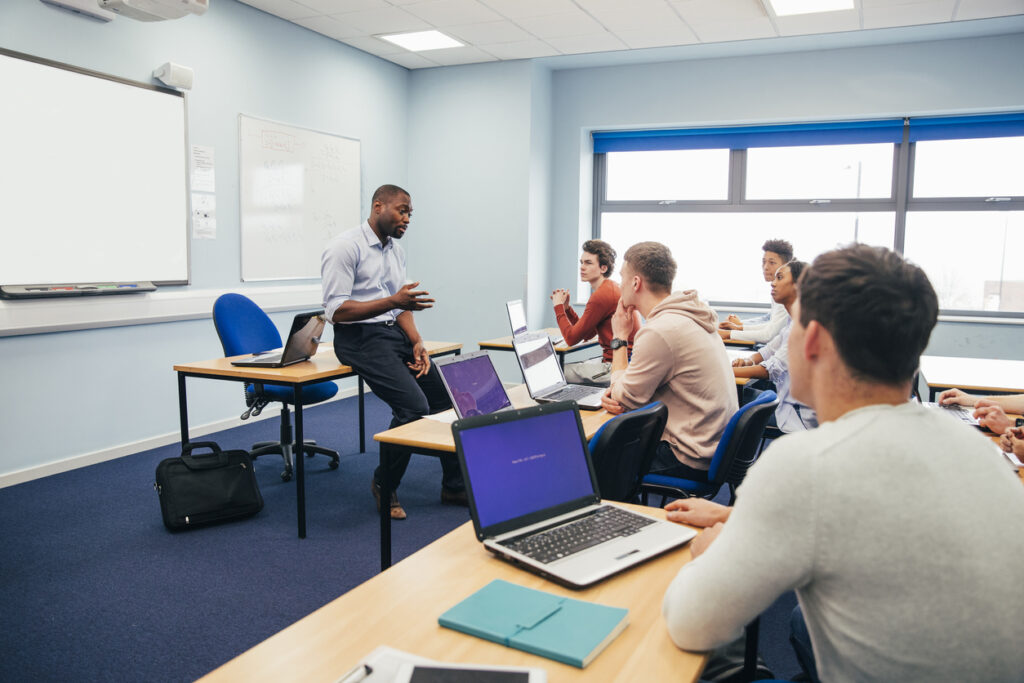It’s impossible to overstate the importance of move-in day and student orientation in the modern higher education landscape. Done right, onboarding new students into the biggest adventure of their life can have a massive impact on retention, persistence, and long-term success. Getting to that point with engaging student onboarding strategies, of course, is not always easy.
Move-in day is stressful almost by definition, from the organized chaos of managing traffic flow to the stress of many students leaving their families for the first time. Add to that the information overload that tends to come with orientation. Then it’s easy to see that this is one area where innovation can be immensely beneficial.
Make no mistake: the first 30 days on campus play a significant role in student success. Also, with the demographic cliff of high school graduates looming, student success holds greater significance than ever before. It’s why, in a recent webinar, we invited higher education orientation, onboarding, and first-year experience professionals to discuss the strategies they use to ensure long-term success.
Keep reading for a high-level overview. You can also watch the full webinar on Innovating Student Onboarding Strategies from Move-In Day to Orientation online.
The Student Onboarding Success Pyramid
Most communications and marketing professionals will be familiar with Maslow’s hierarchy of needs, a seminal model for those seeking to understand how basic needs drive actions and decisions. That same concept underlies Concept3D’s student onboarding success pyramid, which considers how different support and resources fit into what students need as they begin their college journey.
Like Maslow’s hierarchy of needs, the student onboarding success pyramid moves from the bottom to the top, with the foundational needs having to be fulfilled first before moving on to more lofty goals. The four basic stages include:
- Basic Needs and Logistics, focusing on items like housing, food, and water. In higher education, this also includes a basic understanding of the physical campus environment so students can understand the lay of the land.
- Guidance and Mentorship, connecting students with staff and faculty members early. This also includes communicating resources effectively and keeping different student demographics in mind to build more personalized communications.
- Community Connections, creating a sense of belonging for incoming students. Helpful initiatives might highlight clubs and activities, promote events, and make it easier to find friends.
- Individual Fulfillment, a longer-term goal that likely won’t be complete until long after orientation. But, while it cannot be met in the first 30 days, it can be a priority for foundational events like move-in day and orientation.
The needs presented in this pyramid form the foundation of what any communication before, during, and after students move in has to accomplish.
Communication Strategies Before Move-In Day
Successful orientation starts long before students first set foot on campus as part of the incoming class. Shawn Ryan, Director of New Student Orientation and Transition Programs at California State University, Chico, explained that the goal for his team is to connect with students and help to solve potential needs as early as March. Surveys to students can help uncover some of these needs, leading to personalized follow-ups with more relevant information.
Multiple Communication Platforms and Channels
Nii Abrahams, Director of First Year Experience at Butler University, concurs. At Butler, the strategy has moved from sharing information about moving in to shaping the experience incoming students will have ahead of that time. That includes a better understanding of the process but also humanizes the experience as much as possible. Butler is innovating with two student onboarding strategies in particular:
- A podcast called The Struggle is Real, in which current students and staff who struggled during their first year in college share that experience to help new students feel seen and alleviate at least some stress and anxiety.
- A central platform and incoming student portal in which students can fill out a profile with their interests. They can then match with others and even start forming small groups of shared interests before they ever meet in person.
Dr. Laura Truxler, a professor at Holy Names University with more than ten years as a First-Year Experience program director, shared the faculty perspective on this stage of the student onboarding process. Especially during summer, low-stakes engagements with students can be key to:
- Introducing the FYE program
- Introducing the professor teaching the first-year seminar
- Asking students to share what they might be excited about
This introduces early rapport that can pay off significantly down the road.
Virtual Tours
Finally, consider the benefit of sharing visual campus-focused content with students before they move in. Sharing your virtual tour, for instance, gives students a feeling of place on campus. That makes the actual move-in experience much less overwhelming when it’s time to take that step.
How to Orchestrate a Smooth Move-In Day
When it’s time to move in, streamlining communications and processes becomes crucial. A seamless and easy experience for both students and parents can set a positive tone for the beginning of what will become the long-term student journey.
For Butler University, this is an especially challenging process because the campus is in the middle of a residential community. That’s why, as Meg Haggerty, Director of the New Student and Family Program at the university, explained, Butler has embraced a cruise ship move-in model. Families get directed through drive-through tents. There, they’ll receive paperwork, orientation materials, and directions on what residence hall to go to. Once at the drop-off spot, their luggage and belongings get moved out of their car by a crew of helpers. By the time the family parks in the parking garage and gets to the room, the student’s belongings will be waiting for them.
Beyond that, it’s about creating a welcoming atmosphere through your student onboarding strategies. Resource fairs, relaxation stations, and integration of orientation guides are all mentioned to make the experience as smooth as possible. So is an early introduction of the roommate—as well as a smooth transition from move-in day to orientation so that students can quickly meet their peers and build that sense of belonging and connection.
Finally, clearly organized information becomes vital. LSU, for example, uses Concept3D’s interactive map platform to create a category specifically for move-in day. This innovation makes it easy for students and families to find:
- Parking lots
- Staging areas
- The residence halls into which the new student is about to move
How to Design an Impactful Student Orientation
The logistics of move-in day quickly get replaced with the information overload of orientation. Also, as multiple panelists emphasized, orientation can only be successful as a clear partnership between multiple areas of the university.
Student Affairs and Academic Affairs become especially valuable campus partners when it comes to student onboarding strategies. The goal has to be setting up students for success on the first day of class, including and especially students for whom the transition is more drastic, like first-gen and international students who are not yet used to what others might consider a typical university experience.
Student Onboarding Strategies: Actionable Examples to Consider
At Holy Names University, all First-Year Experience students spend at least two hours in a classroom (be it in-person, on Zoom, or asynchronous) with students, mentors, and professors. The focus is not on academic work but on creating connections and getting to know one another. Add planned service trips as part of orientation, and students will have up to ten contact hours with their faculty, which eases the transition and makes them more likely to succeed.
Likewise, Butler University prioritizes building community over dumping information on students. The mantra is this: provide the right information at the right time. More information is not always better, as creating a sense of belonging has to be the focus. Other information can fold in throughout the first semester.
Butler University has also begun to prioritize more space for rest and mental health during student orientation, with an explicit goal of helping students start their first class ready and rejuvenated.
As Shawn Ryan emphasized, orientation leaders have to fight back against the natural instinct to tell students everything. Sometimes students just need to know basic information to start. Instead of multiplying interactions, it’s about creating more personalized touchpoints. At California State University, Chico, that means surveying students about their needs and preferences, then recommending events, sessions, and even clubs that might match those preferences.
Prioritize Personalization Throughout Your Student Onboarding Strategies
Personalization, in general, tends to be key. Insights about students preferring smaller group socialization can receive those opportunities. Personalized videos from orientation guides can make the experience more welcoming.
Finally, it’s about centralizing the experience for a single source of truth. The more intentional that process becomes, the easier it will be for students to find the information they’re looking for. Concept3D’s calendar solution, for instance, can become the central source of truth for welcome week and orientation-related events, making it easy to find both featured events and all opportunities for new students to engage.
How to Champion First-Year Student Success Beyond Orientation

Even orientation, of course, is only the beginning. Universities have to build long-term strategies to create belonging and community.
This starts with informing students about what they can expect. Helping them process what will happen their first semester allows them to lean into it. Communication about what happens the first week, first six weeks, etc., can become vital.
Consistency also becomes key. If everyone across the university is on the same page in terms of language, students will find looking for and taking in information much simpler. Cross-office alignment is absolutely necessary to break down silos and put the student at the center of any first-year communication.
Holy Names University has long been successful with a first-year experience seminar. It is also piloting a year-long model that makes the process even more comprehensive. Students who stay with the same faculty and student group for the entire year build a stronger sense of community. Also, information spread over that entire time (from the library to mental wellness and career services) keeps a steady stream of information going without the risk of overload.
At Butler University, meanwhile, including new students’ families in communications has become a priority in student onboarding strategies. A family council can provide insights into the information parents and other family members most need. The council also acts as a point of contact in getting the word out in more authentic ways. That includes a more comprehensive calendar, which has not just academic dates and deadlines but also reminders and pointers for parents on what to ask their students about and when to give them some space.
Leveraging Technology for a More Successful Student Onboarding
From long before move-in day to throughout the entire first year, onboarding new students is a crucial part of ensuring their long-term success. While that process is largely strategic, the right technology can help to execute those strategies more effectively.
As mentioned throughout, Concept3D can provide at least some of those technology solutions. Virtual tours can create a sense of space for students before move-in day. Simultaneously, interactive maps streamline the actual move-in process. Meanwhile, a central event calendar can simplify the experience at and beyond orientation.
Our solutions are designed for higher education, built on years of experience working with partners in all parts of the area. Ready to learn more about using technology to power your student onboarding strategies? Contact us to get started today.

